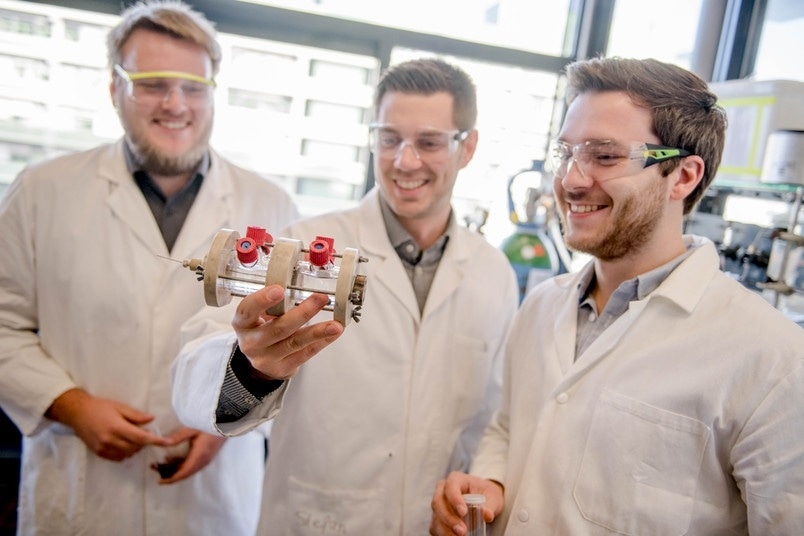Nov 19 2018
A catalyst for carbon dioxide (CO2) recycling, mineral pentlandite could also be a plausible substitute for expensive precious metal catalysts. This is the result of a research carried out by scientists from Ruhr-Universität Bochum (RUB), Fritz-Haber Institute Berlin and Fraunhofer Umsicht in Oberhausen. Pentlandite had formerly been known as a catalyst for hydrogen manufacture. By incorporating an appropriate solvent, the scientists successfully utilized it to change carbon dioxide into carbon monoxide. The latter is a typical source material in the chemical sector.
 Kai junge Puring, Stefan Piontek and Mathias Smialkowski (from left), members of the group led by Ulf-Peter Apfel, with the electroloysis cell in which the experiments were carried out. (© RUB, Marquard)
Kai junge Puring, Stefan Piontek and Mathias Smialkowski (from left), members of the group led by Ulf-Peter Apfel, with the electroloysis cell in which the experiments were carried out. (© RUB, Marquard)
The research team was led by Dr. Ulf-Peter Apfel, Chair of Inorganic Chemistry I in Bochum, and along with their colleagues, the findings have been described in the November 5th, 2018 issue of the journal Chemical Science.
CO2 conversion replaces hydrogen production
“The conversion of CO2 into valuable source materials for the chemical industry is a promising approach to combatting climate change,” says Ulf-Peter Apfel. “However, we currently don’t know many cheap and readily available catalysts for CO2 reduction.” Furthermore, potentially suitable catalysts mainly facilitate another chemical reaction, i.e. the synthesis of hydrogen – these including pentlandite. However, the scientists have effectively changed the mineral to be a CO2 catalyst.
They created electrodes from pentlandite and examined under which circumstances production of carbon monoxide or hydrogen occurred at their surface. “The decisive factor was water being present at the electrode surface,” encapsulates Ulf-Peter Apfel. A lot of water shifted the reaction towards hydrogen generation, some water towards carbon monoxide production. By regulating the water content, the scientists were thus able to produce carbon monoxide and hydrogen mixtures. “Synthetic gas mixtures like this one play a crucial role in the chemical industry,” highlights Apfel.
Stabile catalyst
Pentlandite contains iron, sulfur, and nickel and resembles catalytically active enzyme centers that exist in nature, such as hydrogen-producing hydrogenases.
A huge advantage of this mineral is the fact that it remains stable when confronted with other chemical compounds that occur in industrial emissions and are poison to many catalysts.
Dr. Ulf-Peter Apfel, Chair of Inorganic Chemistry I, Ruhr-Universität Bochum
Funding
The project received financial support through a Liebig-Grant by the Chemical Industry Fund, the German Research Foundation (Emmy Noether Grant AP242/2-1 and DFG project AP242/6-1) and as part of the Fraunhofer internal programs (no. Attract 097-602175). Extra funding was supplied by the German Federal Ministry of Education and Research under the umbrella of the “CO2EKAT” project (03SF0523C).